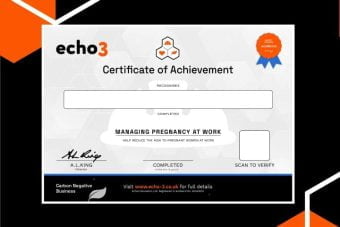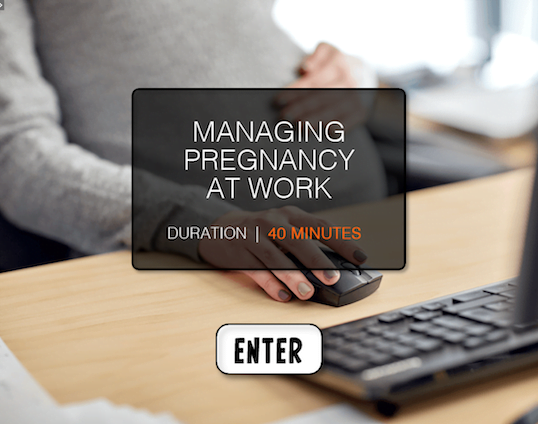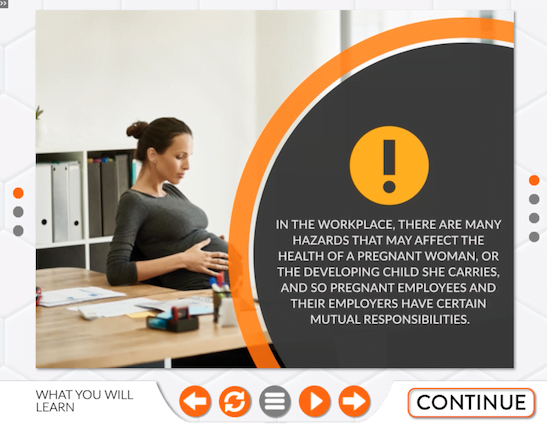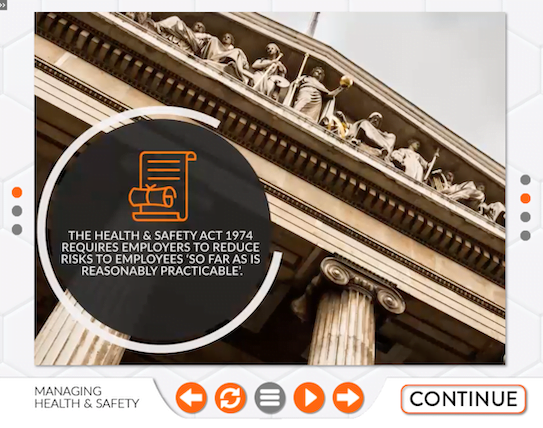Managing Pregnancy at Work Course
When managing pregnancy at work its important to know that additional hazards may affect the health of a woman, or the developing child she carries. So, employers must consider these risks as part of their risk assessment. Then, employers must ensure these risks are minimised.
For example, additional risks can arise from; lifting & carrying; excessive sitting or standing without adequate breaks; and toxic substances.
This online course helps managers and staff understand how to best manage pregnancy at work and comply to regulations.
Course Content
UNIT 1 | Health & Safety Regulations
UNIT 2 | Safe Practice at work
UNIT 3 | Good Risk Assessment Practice
Managing Pregnancy Certificate

On successful completion of the Managing Pregnancy at Work course candidates receive an echo3education completion certificate, available as a PDF for immediate download. This requires achievement of the required pass mark during the final assessment.
Course Preview
Echo3 courses include engaging motion-graphic video content, with full english subtitles
Who is this course for?
- HR personnel
- Managers & Supervisors
- Expectant mothers
What are employer’s legal duties to pregnant women?
There is a range of workplace hazards that could affect the health and safety of a new or expectant mother or her child. Appropriate action should be taken to identify, and remove or reduce the risks associated with these hazards.
The Health & Safety Act 1974 requires employers to reduce risks to employees ‘so far as is reasonably practicable’. In other words, an employer is expected to take measures to avoid or reduce risk so long as those measures are not technically impossible or if the time, trouble or cost of the measures is not grossly disproportionate to the risk. For example, providing a pregnant employee with a comfortable workstation is not difficult in terms of time, trouble or cost and therefore should be done.
The Management of Health and Safety Regulations (MHSW for short) require employers to identify appropriate steps through periodic risk assessments.
Employers must include hazards to new and expectant mothers, when conducting a general workplace risk assessment. We cover the common hazards in the course.
If you employ over 5 people you must keep a written record of your risk assessment.
Any breach of Health and Safety legislation in relation to new and expectant mothers is considered automatic sex discrimination.
When should employer’s know about a pregnancy?
Legally, employees don’t have to tell their employer about their pregnancy until the 15th week before the baby is due. However, many choose to do so after the first trimester, once they’ve had their first scan, to ensure that appropriate health and safety precautions are in place.
Employers should consider helping pregnant employees:
- Avoid strenuous manual handling activities wherever possible
- Wear sensible footwear and be alert to slip, trip and fall hazards
- Ensure that they take regular short breaks when using computers
- Adjust their DSE workstation to accommodate their changing requirements
- Ensure that they are aware of the fire evacuation procedure for their site area













